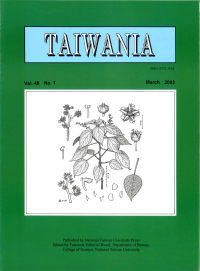Research Paper
Population Structure and Substrates of Taiwan Yellow False Cypress (Chamaecyparis obtusa var. formosana) in Yuanyang Lake Nature Reserve and Nearby Szumakuszu, Taiwan
Chi-Cheng Liao, Chang-Hung Chou and Jiunn-Tzong Wu
Published on: March 2003
Page: 6 - 21
DOI: 10.6165/tai.2003.48(1).6
Abstract
Chamaecyparis obtusa Sieb. & Zucc. var. formosana (Hayata) Rehder (Taiwan yellow false cypress) is one of the most important sources of timber in Taiwan. For sustainable use of this species, basic information about its regeneration under natural conditions is required, but this has been few until now. In this paper, the composition, population structure, growing substrates, and recruitment of Taiwan yellow false cypress were studied in Yuanyang Lake Nature Researve (YYL) and nearby Szumakuszu (SMKS) area, Taiwan. Two study sites in YYL were selected for comparison: one near a lakeshore (LS) and another at a mountain ridge top (MR). A site also was studied at SMKS, located 2 km west of the lake. Within each site, all woody plants with basal diameters larger than 1 cm, and population structures were recorded and analyzed in order to elucidate the recruitment pattern of Taiwan yellow false cypress. It was documented that floristic composition and canopy structure differed among the sites. An inverse J-shaped size distribution pattern for plants growing on down logs at the LS and MR sites suggests a stable and continuous recruitment of Taiwan yellow false cypress at both YYL locations. In contrast, the Taiwan yellow false cypress at SMKS had a discontinuous size distribution, independent of inhabited substrate type. For regeneration of Taiwan yellow false cypress in SMKS, a large-scale disturbance, instead of single uprooted trees, may be necessary. The results indicate that down log is important substrate for regeneration of Taiwan yellow false cypress, particularly in forests at the YYL, LS and MR. Based on the findings in YYL, some down logs are suggested to leave in clear cutting plantation, because they might provide suitable space for regeneration of Taiwan yellow false cypress. This suggestion is expected to reduce the cost and work frequency of management.
中文摘要
台灣扁柏是台灣重要的木材資源,為了永續利用此資源,有必要瞭解其在天然情況 下的更新情形。然而,此方面的研究至今尚十分欠缺,本論文嘗試在塔克金溪流域的鴛鴦湖自然保留區及鄰近司馬庫斯的森林中,研究台灣扁柏所生長的林相組成、族群結構、生長基質及更新特性。在保留區內選定鄰近湖泊 (LS) 及接近稜線 (MR) 處各一個樣區;並在湖泊西邊兩公里的鞍部,接近司馬庫斯村落的附近也選定一樣區(SMKS 樣區),作為比較。樣區中每一株木本植物其離地面30 公分處的直徑 (地徑) 大於1 公分者,皆列入種類及地徑之紀錄。此外,並對台灣扁柏在不同基質上的族群結構加以分析,以瞭解其更新的特性。研究結果發現,植物組成及樹冠結構在三個樣區中皆有差異。而台灣扁柏的族群結構在LS 樣區及MR 樣區的枯倒木生長基質上呈現反J 型,代表在鴛鴦湖保留區的森林中,台灣扁柏有持續更新的現象。不過在SMKS 樣區則顯示非連續的族群結構,並且與生長基質沒有明顯的相關性。據此推論在SMKS 附近的森林中,台灣扁柏在大面積干擾後的更新機會比在小面積干擾後的機會大,顯示在鴛鴦湖保留區內枯倒木對於台灣扁柏的更新有其重要性。因此,散置的枯倒木可提供年幼的台灣扁柏小苗一個生長的基質,因而增強其與其他植物的競爭能力。此同時可以減少除草和疏伐等干擾的頻率,而節省林業經營所需的花費。
Keyword: Chamaecyparis obtusa var. formosana, Down log, Growing substrate, Population structure, Regeneration


